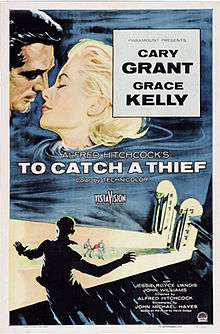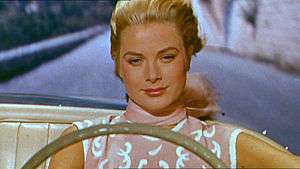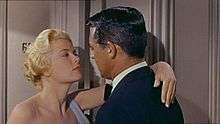To Catch a Thief
| To Catch a Thief | |
|---|---|
 Original film poster | |
| Directed by | Alfred Hitchcock |
| Produced by | Alfred Hitchcock |
| Screenplay by | John Michael Hayes |
| Based on |
To Catch a Thief 1952 novel by David Dodge |
| Starring |
Cary Grant Grace Kelly Jessie Royce Landis John Williams Charles Vanel Brigitte Auber |
| Music by | Lyn Murray |
| Cinematography | Robert Burks |
| Edited by | George Tomasini |
| Distributed by | Paramount Pictures |
Release date |
|
Running time | 106 minutes |
| Country | United States |
| Language | English |
| Budget | $2.5 million |
| Box office |
$4.5 million (US rentals original release)[1] $8.75 million |
To Catch a Thief is a 1955 romantic thriller directed by Alfred Hitchcock, from a screenplay by John Michael Hayes based on the 1952 novel of the same name by David Dodge.[2] The film stars Cary Grant[2] as a retired cat burglar[2] who has to save his reformed reputation by catching a new "cat" preying on the wealthy tourists of the French Riviera. Grace Kelly[2] stars opposite him as his romantic interest in her final film with Hitchcock.
Plot
The modus operandi of a string of jewel robberies in the French Riviera causes the police to believe that the infamous jewel thief or "cat burglar" John Robie (Cary Grant), nicknamed "The Cat", has left his retirement of growing grapes and flowers. The police are unable to detain him for questioning as he gives them the slip first at his hilltop villa.
Robie visits a restaurant. The staff are his old gang from his French Resistance days, paroled based on patriotic war work as long as they keep clean. Bertani, Foussard, and the others blame Robie, because they are currently all under suspicion while the new Cat is active. Still, when the police arrive at Bertani's restaurant, Foussard's teenage daughter Danielle (Brigitte Auber), who has a crush on Robie, spirits him to safety.
Robie can prove his innocence if he can catch the new Cat in the act. He enlists the aid of an insurance man, H. H. Hughson (John Williams), who reluctantly obtains a list of the most expensive jewelry owners currently on the Riviera. Widow Jessie Stevens (Jessie Royce Landis) and her daughter Frances (Grace Kelly) top the list. Robie strikes up a friendship with them. Jessie's delighted but Frances offers a pretense of modesty. When Robie and Frances run into Danielle at the beach, Robie keeps up the mask of being a wealthy American tourist, despite Danielle's jealous barbs about his interest in Frances.




Frances sees through Robie's cover as an American tourist. She seduces him, dangling before him her jewels, teases him with steamy tales of rooftop escapades, and offers herself as an accomplice who might share his crimes. Fireworks fill the night sky.
The next morning, Jessie discovers her jewels are gone. Robie is accused by Frances of being merely a distraction so he could steal her mother's jewelry. The police are called, but Robie has disappeared.
To catch the new Cat, Robie stakes out an estate at night. He struggles with an attacker, who loses his footing and tumbles over a cliff. It is Foussard, who dies in the fall. The police chief publicly announces that Foussard was the jewel thief, but, as Robie points out privately in the presence of the abashed Hughson, this would have been impossible because Foussard had a wooden leg, and could not climb on rooftops.
Foussard's funeral is marred by Danielle's loud accusation that Robie is responsible for her father's death. Outside the graveyard, Frances apologizes to Robie and confesses her love. Robie needs to continue his search for the Cat. He asks Frances to arrange his attendance at the masquerade ball the coming weekend, when he believes the Cat will strike again.
At the ball, Frances is resplendent in a gold gown, Robie unrecognizable behind the mask of a Moor. The police hover nearby. Upstairs, the cat burglar silently cleans out several jewel boxes. When Jessie asks the Moor to go get her "heart pills", Robie's voice tips off his identity to the authorities. Upon his return, the police wait out Frances and the Moor as they dance together all night. Finally, Frances and the Moor go to her room, and the mask is removed: it was Hughson, a switch to conceal Robie's exit.
On the rooftop Robie lurks. His patience is finally rewarded when he is joined by another figure in black. But just as his pursuit begins, the police throw a spotlight on him and demand he halt. He flees as they shoot at him, but he manages to corner his foe with jewels in hand. Unmasked, his nemesis turns out to be Foussard's daughter, Danielle. She slips off the roof, but Robie grabs her hand before she can fall. He forces her to confess loudly to the police of the father-daughter involvement, and that Bertani was the ringleader of this gang.
Robie speeds back to his villa, and Frances races after to convince him that she has a place in his life and home. He agrees, but looks less than thrilled when she says, "Mother will love it up here."
Cast
- Cary Grant as John Robie ("The Cat")
- Grace Kelly as Frances Stevens
- Jessie Royce Landis as Jessie Stevens
- John Williams as H. H. Hughson
- Charles Vanel as Monsieur Bertani
- Brigitte Auber as Danielle Foussard
- Jean Martinelli as Foussard, Danielle's father
- Georgette Anys as Germaine, housekeeper
- René Blancard as Commissaire Lepic (uncredited)
Alfred Hitchcock makes his signature cameo approximately ten minutes in as a bus passenger sitting next to Cary Grant.
Despite Brigitte Auber's character being referred to as a "girl" or "teenager", compared to Grace Kelly's supposedly more mature character, Auber was actually 26 years old at the time of filming and more than a year and a half older than Kelly.
Production
This was Hitchcock's first of five films in the widescreen process VistaVision,[3] and final film with Grace Kelly. The film also led to another successful collaboration with Cary Grant, the 1959 classic North by Northwest (also about a man with a mistaken identity who goes on a breakneck adventure to prove his innocence).
The costumes were by Edith Head, including Kelly's memorable gold lamé gown for the film's costume ball.
Distribution
To Catch a Thief is the only Hitchcock film released by Paramount that is still owned and controlled by the company. The others were sold to Hitchcock in the early 1960s and are currently distributed by Universal Studios.
Awards and honors
Robert Burks won the Academy Award for Best Cinematography, while Hal Pereira, Joseph McMillan Johnson, Samuel M. Comer and Arthur Krams were nominated for Best Art Direction, and Edith Head was nominated for Best Costume Design.[4]
In 2002, American Film Institute included the film in AFI's 100 Years...100 Passions (#46).[5]
See also
References
- ↑ "The Top Box-Office Hits of 1955", Variety Weekly, January 25, 1956
- 1 2 3 4 Crowther, Bosley (August 5, 1955). "To Catch a Thief (1955) Screen: Cat Man Out 'To Catch a Thief'; Grant is Ex-Burglar in Hitchcock Thriller". The New York Times.
- ↑ Orengo 2006
- ↑ "The 28th Academy Awards – 1956". Academy of Motion Picture Arts and Sciences. Retrieved August 23, 2016.
- ↑ "AFI's 100 Years...100 Passions" (PDF). American Film Institute. 2002. Retrieved August 23, 2016.
Bibliography
- De Rosa, Steven (2001). Writing with Hitchcock: The Collaboration of Alfred Hitchcock and John Michael Hayes. Faber and Faber. ISBN 0571199909.
- Orengo, Nico (2006). La Guerra del Basilico (The Basil War (in Italian). Einaudi. ISBN 880618296X.
- Spoto, Donald (1999). The Dark Side of Genius. Da Capo. ISBN 0-306-80932-X.
- Vest, James M. (2003). Hitchcock and France: The Forging of an Auteur. Praeger. ISBN 0275970892.
Further reading
- "Two Interviews About To Catch a Thief" by Tifenn Brisset, Film International magazine Vol. 11, No. 6, 2013, pages 13–21. Interviews with French script supervisor Sylvette Baudrot conducted September 2011 and actress Brigitte Auber, September 2011, March 2013, regarding their work on the film and with Cary Grant and Alfred Hitchcock. Discussion of a different ending and script differences. Twelve color photographs, nine pages.
External links
| Wikimedia Commons has media related to To Catch a Thief (film). |
| Wikiquote has quotations related to: To Catch a Thief |
- To Catch a Thief on IMDb
- To Catch a Thief at AllMovie
- To Catch a Thief at the TCM Movie Database
- To Catch a Thief at the American Film Institute Catalog
- To Catch a Thief at Rotten Tomatoes
- Historic reviews, photo gallery at CaryGrant.net